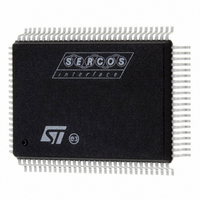ST92F150CV1QB STMicroelectronics, ST92F150CV1QB Datasheet - Page 297

ST92F150CV1QB
Manufacturer Part Number
ST92F150CV1QB
Description
MCU 8BIT 128K FLASH 100PQFP
Manufacturer
STMicroelectronics
Series
ST9r
Datasheet
1.ST92F150CV1TB.pdf
(429 pages)
Specifications of ST92F150CV1QB
Core Processor
ST9
Core Size
8/16-Bit
Speed
24MHz
Connectivity
CAN, I²C, LIN, SCI, SPI
Peripherals
DMA, LVD, POR, PWM, WDT
Number Of I /o
77
Program Memory Size
128KB (128K x 8)
Program Memory Type
FLASH
Eeprom Size
1K x 8
Ram Size
4K x 8
Voltage - Supply (vcc/vdd)
4.5 V ~ 5.5 V
Data Converters
A/D 16x10b
Oscillator Type
Internal
Operating Temperature
-40°C ~ 105°C
Package / Case
100-QFP
Processor Series
ST92F15x
Core
ST9
Data Bus Width
8 bit, 16 bit
Data Ram Size
6 KB
Interface Type
CAN, I2C, SCI, SPI
Maximum Clock Frequency
24 MHz
Number Of Programmable I/os
80
Number Of Timers
5 x 16 bit
Operating Supply Voltage
4.5 V to 5.5 V
Maximum Operating Temperature
+ 105 C
Mounting Style
SMD/SMT
Development Tools By Supplier
ST92F150-EPB
Minimum Operating Temperature
- 40 C
On-chip Adc
16 bit x 10 bit
Lead Free Status / RoHS Status
Lead free / RoHS Compliant
Other names
497-4882
Available stocks
Company
Part Number
Manufacturer
Quantity
Price
Company:
Part Number:
ST92F150CV1QB
Manufacturer:
STMicroelectronics
Quantity:
10 000
- Current page: 297 of 429
- Download datasheet (8Mb)
J1850 BYTE LEVEL PROTOCOL DECODER (Cont’d)
10.9.4 Peripheral Functional Modes
The JBLPD can be programmed in 3 modes, de-
pending on the value of the JE and JDIS bits in the
CONTROL register, as shown in
Table 55. JBLPD functional modes
Depending on the mode selected, the JBLPD is
able or unable to transmit or receive messages.
Moreover the power consumption of the peripheral
is affected.
Note: The configuration with both JE and JDIS set
is forbidden.
10.9.4.1 JBLPD Enabled
When the JBLPD is enabled (CONTROL.JE=1), it
is able to transmit and receive messages. Every
feature is available and every register can be writ-
ten.
10.9.4.2 JBLPD Suspended (Low Power Mode)
When the JBLPD is suspended (CONTROL.JE=0
and CONTROL.JDIS=0), all the logic of the
JBLPD is stopped except the decoder logic.
This feature allows a reduction of power consump-
JE
0
0
1
JDIS
1
0
0
mode
JBLPD Disabled
JBLPD Suspended
JBLPD Enabled
Table
55.
J1850 Byte Level Protocol Decoder (JBLPD)
tion when the JBLPD is not used, even if the de-
coder is able to follow the bus traffic. So, at any
time the JBLPD is enabled, it is immediately syn-
chronized with the J1850 bus.
Note: While the JBLPD is suspended, the STA-
TUS register, the ERROR register and the SLP bit
of the PRLR register are forced into their reset val-
ue.
10.9.4.3 JBLPD Disabled (Very Low Power
Mode)
Setting the JDIS bit in the CONTROL register, the
JBLPD is stopped until the bit is reset by software.
Also the J1850 decoder is stopped, so the JBLPD
is no longer synchronized with the bus. When the
bit is reset, the JBLPD will wait for a new idle state
on the J1850 bus. This mode can be used to mini-
mize power consumption when the JBLPD is not
used.
Note: While the JDIS bit is set, the STATUS regis-
ter, the ERROR register, the IMR register and the
SLP, TEOBP and REOBP bits of the PRLR regis-
ter are forced to their reset value.
Note: In order that the JDIS bit is able to reset the
IMR register and the TEOBP and REOBP bits, the
JDIS bit must be left at 1 at least for 6 MCU clock
cycles (3 NOPs).
Note: The JE bit of CONTROL register cannot be
set with the same instruction that reset the JDIS
bit. It can be set only after the JDIS bit is reset.
297/429
9
Related parts for ST92F150CV1QB
Image
Part Number
Description
Manufacturer
Datasheet
Request
R

Part Number:
Description:
BOARD PROGRAM FOR ST92F150 MCU
Manufacturer:
STMicroelectronics
Datasheet:

Part Number:
Description:
BOARD EVALUATION FOR ST9 SERIES
Manufacturer:
STMicroelectronics
Datasheet:

Part Number:
Description:
BOARD EMULATOR FOR ST9 SERIES
Manufacturer:
STMicroelectronics
Datasheet:

Part Number:
Description:
MCU, MPU & DSP Development Tools ST9 Dedication Board
Manufacturer:
STMicroelectronics
Datasheet:

Part Number:
Description:
STMicroelectronics [RIPPLE-CARRY BINARY COUNTER/DIVIDERS]
Manufacturer:
STMicroelectronics
Datasheet:

Part Number:
Description:
STMicroelectronics [LIQUID-CRYSTAL DISPLAY DRIVERS]
Manufacturer:
STMicroelectronics
Datasheet:

Part Number:
Description:
BOARD EVAL FOR MEMS SENSORS
Manufacturer:
STMicroelectronics
Datasheet:

Part Number:
Description:
NPN TRANSISTOR POWER MODULE
Manufacturer:
STMicroelectronics
Datasheet:

Part Number:
Description:
TURBOSWITCH ULTRA-FAST HIGH VOLTAGE DIODE
Manufacturer:
STMicroelectronics
Datasheet:

Part Number:
Description:
Manufacturer:
STMicroelectronics
Datasheet:

Part Number:
Description:
DIODE / SCR MODULE
Manufacturer:
STMicroelectronics
Datasheet:

Part Number:
Description:
DIODE / SCR MODULE
Manufacturer:
STMicroelectronics
Datasheet:











